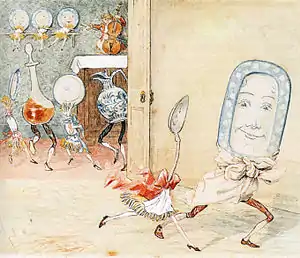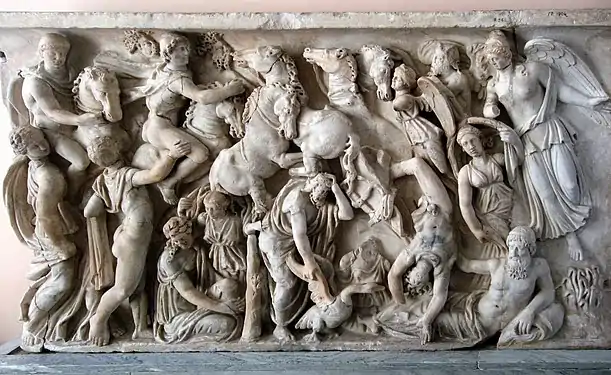The Man in the Moon Stayed Up Too Late
"The Man in the Moon Stayed Up Too Late" is J. R. R. Tolkien's imagined original ditty behind the nursery rhyme "Hey Diddle Diddle (The Cat and the Fiddle)", invented by back formation. The title of the extended 1962 version is given in The Adventures of Tom Bombadil. It was first published in Yorkshire Poetry in 1923.[1]

Scholars have noted that the light-hearted poem fits into a reworking by Tolkien of the Man in the Moon tradition, from myths such as of Phaethon who drove the Sun too close to the Earth, down through the medieval story of the unlucky man who was banished to the Moon, and ultimately to a short nursery rhyme. Tolkien similarly wrote a myth of the creation, with the Sun and Moon carried on ships across the sky; and a story of an Elf who hid on the Ship of the Moon.
The song has been recorded by The Tolkien Ensemble.
Context
In The Prancing Pony Inn at Bree, Frodo Baggins jumps on a table and recites "a ridiculous song" supposedly invented by his cousin Bilbo. "Here it is in full," said Tolkien, alluding to the shortness of the nursery rhyme "Hey Diddle Diddle". "Only a few words of it are now, as a rule, remembered."[T 1]
Song
beneath an old grey hill,
And there they brew a beer so brown
That the Man in the Moon himself came down
one night to drink his fill.
The ostler has a tipsy cat
that plays a five-stringed fiddle;
And up and down he runs his bow,
Now squeaking high, now purring low,
now sawing in the middle.
The song, or tale, is, in the 1962 version published in The Adventures of Tom Bombadil, in thirteen ballad-like five-line stanzas. These introduce each element in turn: the Man in the Moon, the musical cat, the little dog, the hornéd cow and the silver dishes and spoons. The rhyming scheme is ABCCB.[2][T 2]
The 1923 version, slightly shorter, was called "The Cat and the Fiddle: or A Nursery Rhyme Undone and its Scandalous Secret Unlocked".[2][T 3]
Reception
An imagined prehistory of poetry
The Tolkien scholar Tom Shippey notes that nobody would call "The Man in the Moon Stayed Up Too Late" a serious poem. All the same, he cites it and its mate, "The Man in the Moon Came Down Too Soon" (also from 1923, also subsequently included in The Adventures of Tom Bombadil) as typical examples of Tolkien's working strategy for reconstructing philological information about sources now lost.[3] In this case the question is: what lies behind the abbreviated version of this poem that survives as a well-known but nonsensical nursery rhyme? By imagining a text that might reasonably have left the surviving rhyme, one can deduce clues that might have left other artifacts in surviving literature. Shippey argues that many of the scenarios in Tolkien's more serious work are similar recreations ("'asterisk' poems" in Shippey's phrase), attempting to explain abstruse passages in surviving Old English and Old Norse texts. The seemingly frivolous nursery rhymes are taken to have[3]

contain[ed], at least in their early versions, hints of mythological significance – the Man in the Moon who fails to drive his chariot while mortals panic and his white horses champ their silver bits and the Sun comes up to overtake him is not totally unlike the Greek myth of Phaethon, who drove the horses of the sun too close to Earth and scorched it."[3]
Steven M. Deyo, in Mythlore, notes that Tolkien introduced the poem by saying that it "must be derived ultimately from Gondor ... based on the traditions of Men".[T 4][4] Deyo agrees that "traditions of Men" is correct; the poem is based on the Harley manuscript poem 2253, quoting Shippey that it is "perhaps the best medieval English lyric surviving, and certainly one of the hardest" to interpret. He endorses Shippey's suggestion of an imagined prehistory of the nursery rhyme, where[4]
If one assumes a long tradition of 'idle children' repeating 'thoughtless tales' in increasing confusion, one might think that poems like Tolkien's were the remote ancestors of the modern rhymes.[3]
Performance versus folklore transmission
The Tolkien scholar Dimitra Fimi writes that Tolkien is clearly setting Frodo's song apart as a performance of a traditional work. She states that readers quickly appreciate that Frodo's performance of an entertaining but "ridiculous song", supposedly written by his cousin Bilbo, is evidently "a highly sophisticated and literary derivative of the 'real world' nursery rhyme 'The Cat and the Fiddle'". This stands in sharp contrast with Sam Gamgee's recital of "The Stone Troll", at once amusing and "metrically intricate", which the other hobbits make clear is new, and that Sam, despite his basic education, must have created it, with "the rare quality of impromptu improvisation modelled upon traditional forms, a quality that many traditional folksingers display".[5]
Multi-layered tradition
The medievalist Thomas Honegger writes that Tolkien gives the theme of the Man in the Moon a "multi-layered treatment" that gives it a "complexity and depth" comparable with the actual folk tradition that reaches back some eight centuries, spanning the 14th century Middle English "Man in the Moon" poem, Harley 2253, which he quotes at length with a parallel translation. The "nonsensical nursery rhymes" inspired Tolkien's two poems ("... Stayed Up Too Late" and "... Came Down Too Soon"). At the "high mythology" level, the Old Norse myth of Máni corresponds to Tolkien's creation myths with the ships which carry Sun and Moon (Tilion) across the heavens. At the level of story, the unlucky fellow banished to the moon roughly matches (Honegger writes) Tolkien's old elf Uole Kuvion who hid on the Ship of the Moon "and has been living there ever since".[6][T 5][T 6]
| Type | Literary mode | Tolkien | Real-world |
|---|---|---|---|
| Myth | Mythic | Creation, ships carry Sun and Moon across sky | Greek myth of Phaethon; Old Norse myth of Máni |
| Story | High mimetic | Elf Uole Kuvion who hid on Ship of the Moon | Unlucky man banished to Moon |
| Rhyme | Low mimetic | "The Man in the Moon Stayed Up Too Late" | "Hey Diddle Diddle" |
Medieval borrowings
John D. Rateliff notes that Tolkien stated that when he read a medieval work, he wanted to write a modern one in the same tradition. He constantly created these, whether pastiches and parodies like "Fastitocalon"; adaptations in medieval metres, like "The Lay of Aotrou and Itroun" or "asterisk texts" like his "The Cat & The Fiddle"; and finally "new wine in old bottles" such as "The Nameless Land" and Aelfwine's Annals. The works are extremely varied, but all are "suffused with medieval borrowings", making them, writes Rateliff, "most readers' portal into medieval literature". Not all found use in Middle-earth (as "The Cat & The Fiddle" eventually did), but they all helped Tolkien develop a medieval-style craft that enabled him to create the attractively authentic Middle-earth legendarium.[7] Paul N. Hyde writes in Mythlore that the poem was at first a humorous commentary on the plentiful "'nonsense' that had been written" about "The Cat and the Fiddle".[2]
Settings
.jpg.webp)
The Danish Tolkien Ensemble recorded the song on their 1997 CD of settings of songs from The Lord of the Rings, An Evening in Rivendell. It was set by Caspar Reiff and Peter Hall. Af Søren Aabyen, reviewing the album for the Danish Tolkien Association, praised the "playful hobbit-song".[8] Steve Renard recorded his version online,[9] with sheet music.[10]
Appearance in film
In the Extended Edition of the film The Hobbit: An Unexpected Journey, the Dwarf Bofur sings this song at Elrond's feast.[11]
References
Primary
- This list identifies each item's location in Tolkien's writings.
- The Fellowship of the Ring, book 1, ch. 9 "At the Sign of the Prancing Pony"
- The Return of the Shadow, ch. 8 "Arrival at Bree", pp. 141-147
- Tolkien, J. R. R. (1923). "The Cat and the Fiddle: or A Nursery Rhyme Undone and its Scandalous Secret Unlocked". Yorkshire Poetry. 2 (19, October–November): 1–3.
- The Adventures of Tom Bombadil, page 8
- The Silmarillion, ch. 11 "Of the Sun and Moon and the Hiding of Valinor"
- The Book of Lost Tales I, pp. 193, 202, 206
Secondary
- Shippey, Tom (2006). "Poems by Tolkien: The Adventures of Tom Bombadil". In Drout, Michael D. C. (ed.). J.R.R. Tolkien Encyclopedia: Scholarship and Critical Assessment. Taylor & Francis. pp. 515–517. ISBN 978-0-415-96942-0.
- Hyde, Paul Nolan (1989). "Mythos: the Daughter of Mountains, the Mother of Pearls". Mythlore. 16 (1). article 6, pages 31-33.
- Shippey, Tom (2005) [1982]. The Road to Middle-Earth (Third ed.). HarperCollins. pp. 41–42. ISBN 978-0261102750.
- Deyo, Steven M. (1986). "Niggle's Leaves: The Red Book of Westmarch and Related Minor Poetry of J.R.R. Tolkien". Mythlore. 12 (3). Article 8.
- Fimi, Dimitra (March 2009). "Hobbit Songs and Rhymes: Tolkien and the Folklore of Middle-earth". Dimitra Fimi. Retrieved 7 September 2020.
- Honneger, Thomas (2005). "The Man in the Moon: Structural Depth in Tolkien". Root and Branch: Approaches Toward Understanding Tolkien (2nd ed.). Walking Tree Publishers. pp. 9-58 (offprint).
- Rateliff, John D. (2014). "Inside Literature: Tolkien's Explorations of Medieval Genres". In Houghton, John Wm.; Croft, Janet Brennan; Martsch, Nancy (eds.). Tolkien in the New Century: Essays in Honor of Tom Shippey. McFarland. pp. 133–152. ISBN 978-0-7864-7438-7.
- Aabyen, Af Søren (18 May 1998). "Anmeldelser | Musik: An evening in Rivendell" (in Danish). Imladris - Danmarks Tolkien Forening. Retrieved 4 September 2020.
- Renard, Steve. "The Cow Jumped Over the Moon ("Frodo's song set to music")". Signum University. Retrieved 5 September 2020.
- Renard, Steve. "A Nursery Rhyme Undone". Steve Renard. Retrieved 5 September 2020.
- "The Hobbit: An Unexpected Journey Extended Edition Scene Guide". The One Ring.net. Retrieved 4 September 2020.
Further reading
- "Tolkien's Lore: The Songs of Middle-earth" by Diane Marchesani, Mythlore: Vol. 7 : No. 1 , Article 1. (1980)
.jpg.webp)